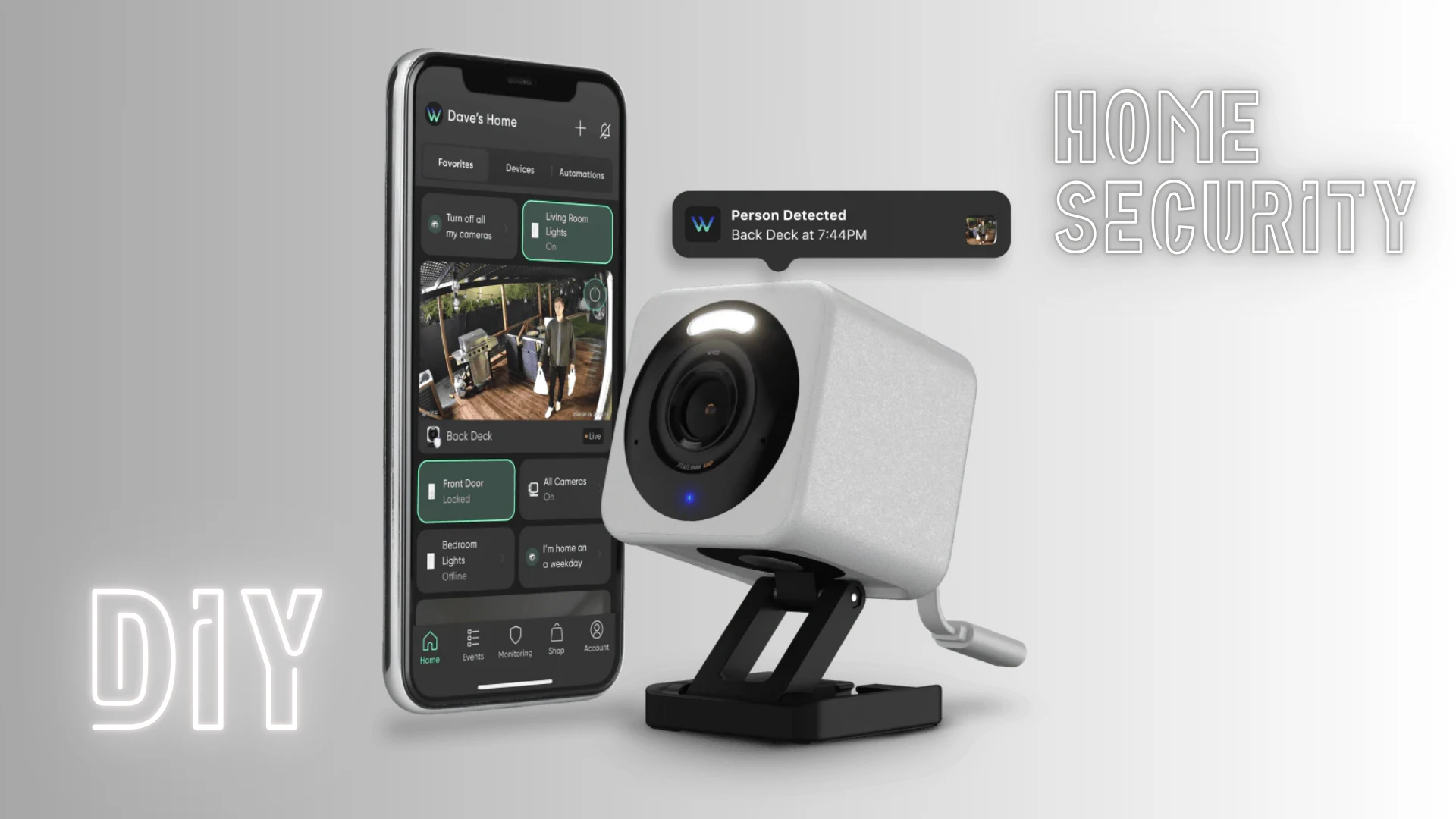In the previous article, Smart Home 101: The Ultimate Beginner’s Guide to Connected Living, we discussed the smart home concept and the steps to building one. You have already decided on your needs, and the next step is choosing the right platform.
The smart home platform is the decision-making center of your smart home. It’s the software system (app or interface) you use to control your devices, set automation, and manage your smart home environment. Think of it as mission control that receives information and sends instructions. Choosing the right platform sets the foundation for a seamless and enjoyable smart home experience. Without a central platform, you’d be stuck managing each device individually through its own app, which can quickly become a chaotic mess.
Factors to Consider When Choosing a Smart Home Platform
Smart Home Goals
Consider your primary use cases for a smart home.
- Basic Automation: If your focus is on automating simple tasks like lighting control or scheduling routines, most platforms offer a range of compatible devices to achieve this.
- Advanced Security Features: For a security-centric smart home, look for platforms that offer strong integrations with security cameras, doorbells, and other monitoring devices. Look for features like remote lock control, activity logs, and security camera integration with motion detection and alerts.
- Energy Efficiency Management: Look for smart home platforms that integrate well with smart thermostats, plugs, and energy monitoring devices. Look for features that allow scheduling and automation based on whether you’re home or environmental conditions, like temperature or time of day.
Compatibility
Smart home devices work within specific ecosystems. Here are some key compatibility considerations:
- Device Compatibility: Check the smart home platform’s compatibility list to see if it supports the smart devices you already own or plan to purchase.
- Brand Compatibility: Look for platforms compatible with popular smart home brands you prefer.
- Protocol Compatibility: Consider the communication protocols your devices use, such as Wi-Fi, Z-Wave, and Zigbee. While some smart home platforms directly connect with Wi-Fi devices, others might require a hub if your devices use Z-Wave or Zigbee protocols. Make sure the platform you choose is compatible with the protocols used by your devices.
If you do not own any smart devices yet, consider only purchasing devices that are compatible with the Matter protocol. This will eliminate the need to install separate hubs and applications for the different brands. It will also make it easier to change the platform in case you later change your mind.
Scalability and Future-proofing
- A key consideration is how well the smart home platform scales. You’ll likely want to add new devices as your smart home grows. Consider a platform that supports various device categories, such as lighting, thermostats, security systems, appliances, and entertainment systems, so you can easily integrate new gadgets and functionalities. Also, opt for a platform that prioritizes future software updates for its compatible devices to guarantee continued functionality over time.
- Smart home platforms can be categorized as open or closed ecosystems. Open platforms offer broader compatibility with various device brands, while closed ecosystems primarily work with the platform’s own devices. Opting for an open platform provides more flexibility.
Voice Assistant Preference as a Smart Home Platform
While choosing a voice assistant based on comfort is important, consider its capabilities, too. For example, Alexa is widely used and known for its extensive skillset and compatibility with many smart home devices. Google Assistant excels at integrating with other Google products and offers strong functionalities for smart home control. Siri prioritizes user privacy and tightly integrates with Apple devices.
Security and Privacy
Evaluating the smart home platform’s security and data privacy practices before integrating it into your smart home is critical.
- Security Measures: Research the platform’s security protocols, such as data transmission and storage encryption standards. Look for platforms that offer features like two-factor authentication and user permission controls.
- Data Privacy Practices: Review the platform’s data privacy policy to understand what data is collected, how it’s used, and with whom it might be shared. Look for platforms with clear and transparent data handling practices and options for users to control their data.
Building and managing your local smart home system has been a longstanding practice. This approach has gained new traction lately, with Home Assistant receiving increasing support from both community developers and established brands. When done right, local systems can become fully independent of big online platforms, especially when combined with Matter-compatible devices.
Budget
The overall cost of your smart home depends on your platform choice.
- Platform Fees: Some platforms have free basic plans with limited functionality, while others require subscriptions for full access to features and automation.
- Device Costs: Smart home devices have varying price points depending on brand, features, and complexity. Factor in the upfront cost of essential devices you’ll need to build your smart home’s core functionality.
- Subscription Services: Certain smart home devices might require ongoing subscriptions. Consider these recurring costs when budgeting for your smart home ecosystem.
Local systems offer a potential cost advantage, eliminating ongoing subscription fees associated with some cloud-based platforms. However, you need to consider the ongoing investment of time, effort, and technical expertise required. As your smart home expands and functionalities become more complex, you might need to upgrade hardware or dedicate time to learning and maintaining the system.
Popular Smart Home Platforms
Amazon Alexa
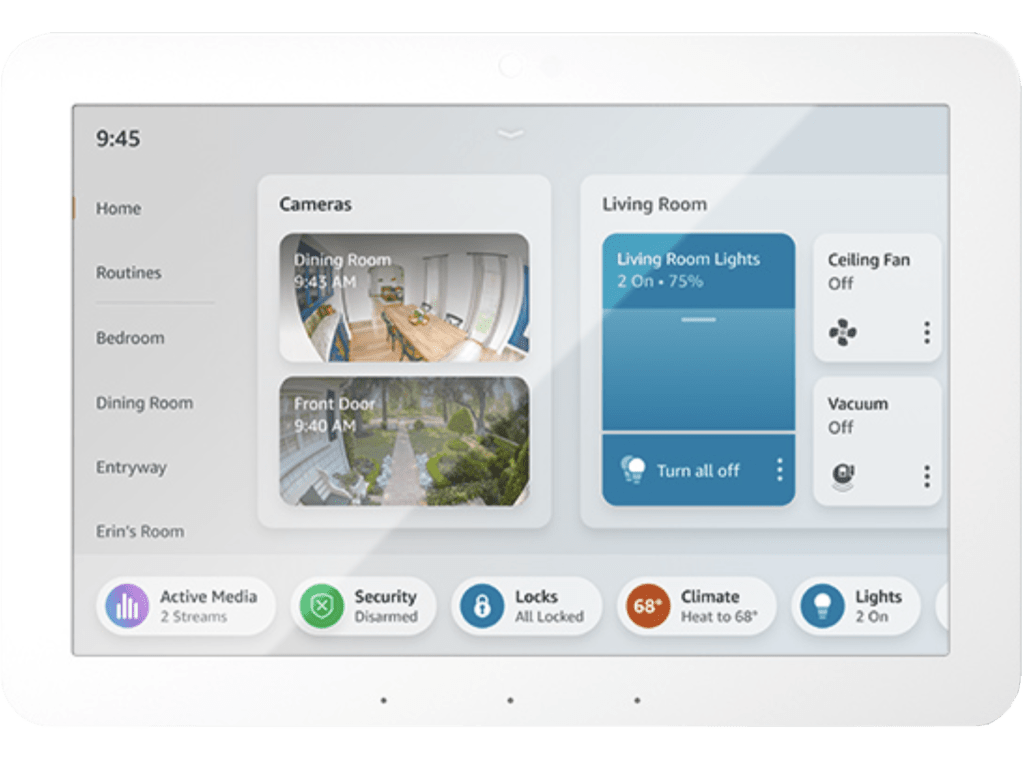
Photo credit: amazon.com
It is a cloud-based voice service and smart home platform developed by Amazon. It uses voice recognition and natural language processing so you can interact with your devices through spoken commands. You will need a smart speaker like Amazon Echo or Echo Dot, but it’s also integrated into various third-party devices, smartphones, and even cars and is also known for its natural language processing capabilities. Beyond its basic smart home control, you can also access news, listen to music, play games, and order products with it. Plus, Alexa has one of the largest ranges of compatible smart home devices from various brands.
Cons
- Privacy Concerns: Like other smart home platforms, Alexa collects user data to function and uses the data to improve its functionalities. You can manage some of your data through your Amazon Alexa account, but it may be limited. Research these practices before choosing Alexa
- Limited Customization: Alexa’s focus on ease of use can come at the expense of customization options. Users who prefer a more granular control over their smart home environment might find other platforms more suitable.
- Amazon Ecosystem Focus: While Alexa works with various brands, some features and integrations are more streamlined with Amazon-owned devices and services.
Google Home
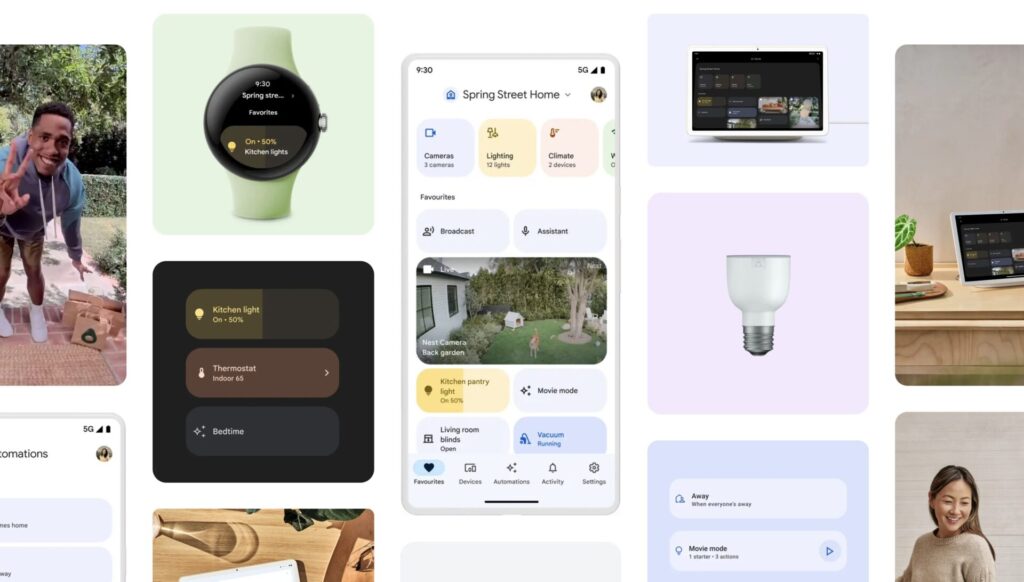
Photo credit: google.com
Google Assistant is a cloud-based virtual assistant and smart home platform developed by Google. Like Alexa, you can control your smart home devices, access information, and perform various tasks through voice commands. Google Assistant is primarily accessed through Google smart speakers and displays like Nest Hub and Nest Audio, but it’s also integrated into smartphones, laptops, and other Google products. It integrates seamlessly with other Google products and services like Gmail, Calendar, and YouTube. This can be quite convenient if you already invested in the Google ecosystem.
With Google’s search engine, it excels at answering questions, finding information online, and providing real-time updates. It offers comprehensive automation routines, and with its machine-learning capability, you will get cool features like proactive suggestions and personalized routines. Google emphasizes user privacy and security, and you can control and manage your data through your Google account settings. Google uses data to personalize your Assistant experience.
Cons
- Hardware Dependence on Google Nest Devices: The core smart home control requires Google Nest hubs or speakers.
Apple HomeKit
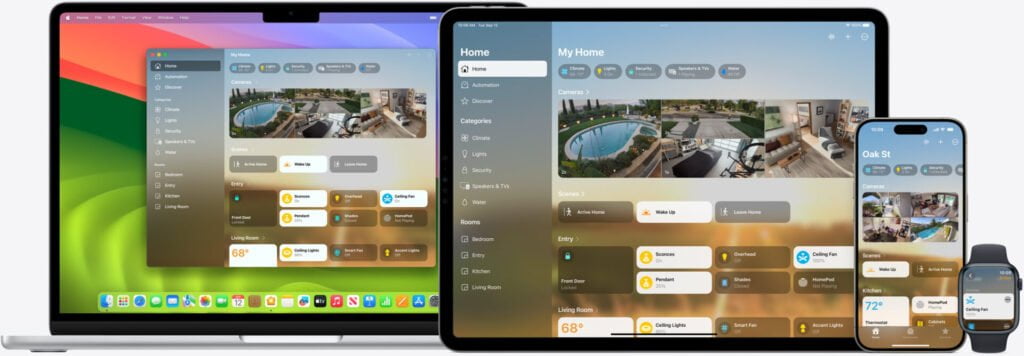
Photo credit: apple.com
Apple HomeKit is a smart home platform encompassing a software framework and communication protocol developed by Apple specifically for iOS, iPadOS, and macOS devices. Users can securely configure, communicate with, and control smart home accessories using their Apple devices. HomeKit prioritizes user privacy and security. Communication between devices and the Home app is encrypted and stored locally on your Apple device or in iCloud with strong access controls. Unlike some other platforms, HomeKit devices do not rely on cloud storage for core functionalities.
Setting up and controlling devices with HomeKit is generally straightforward, particularly if you are already familiar with the Apple ecosystem. Also, Apple devices automatically discover compatible accessories nearby, simplifying the pairing process. With HomeKit, You can create automation triggered by various conditions or actions. For example, if a smart light sensor detects sunrise, your coffee maker starts brewing coffee.
Cons
- Limited Device Compatibility: It is only compatible with Apple devices or with devices that have been certified as “Works with Apple HomeKit.”
- Platform Dependence: It requires Apple devices for control and setup. While some third-party apps can integrate with HomeKit, the core functionality relies on Apple’s ecosystem.
- Fewer Device Options: Compared to platforms like Alexa or Google Assistant, the selection of HomeKit-compatible devices is somewhat smaller.
- Potentially Higher Device Costs: Since Apple curates the HomeKit experience, some compatible smart home devices might be pricier compared to options available for other platforms.
- Limited Automation Capabilities: HomeKit’s automation features might be considered less universal compared to some competitor platforms.
Samsung SmartThings
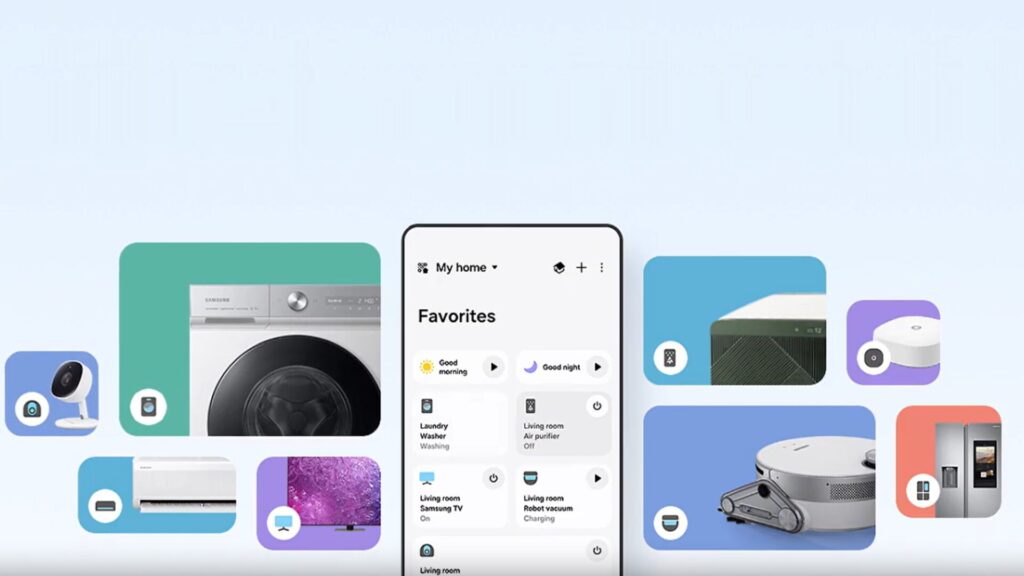
Photo credit: samsung.com
Samsung SmartThings is a smart home platform developed by Samsung Electronics. It simplifies smart home management by offering a central hub that connects and controls various smart home devices from multiple brands, all accessible through a central app. You can build a diverse smart home ecosystem without being restricted to Samsung-branded devices. It promotes interoperability, meaning devices from different brands can communicate and work together within the platform. This is particularly beneficial if you already own smart home devices from various manufacturers.
With SmartThings, you can create complex automation triggered by various conditions and actions. While Samsung offers its own line of SmartThings Hubs, the platform can also function with third-party hubs that utilize Zigbee or Z-Wave protocols. This flexibility allows users to choose the hardware solution that best suits their needs.
Cons
- Hub Requirement: SmartThings requires a separate hub to act as a central communication point for some functionalities, especially those involving Zigbee or Z-Wave devices. This adds an extra cost compared to platforms that rely solely on Wi-Fi connections.
- Complexity for Beginners: The extensive device compatibility and advanced automation features can be overwhelming if you are new to smart homes.
- Samsung Ecosystem Focus: While interoperability is a strength, some features and functionalities might be more optimized for Samsung-branded devices.
- Limited Voice Assistant Integration: SmartThings integrates with popular voice assistants like Google Assistant and Amazon Alexa, but its own voice assistant, Bixby, is less widely used.
Home Assistant: The Local Smart Home Hub
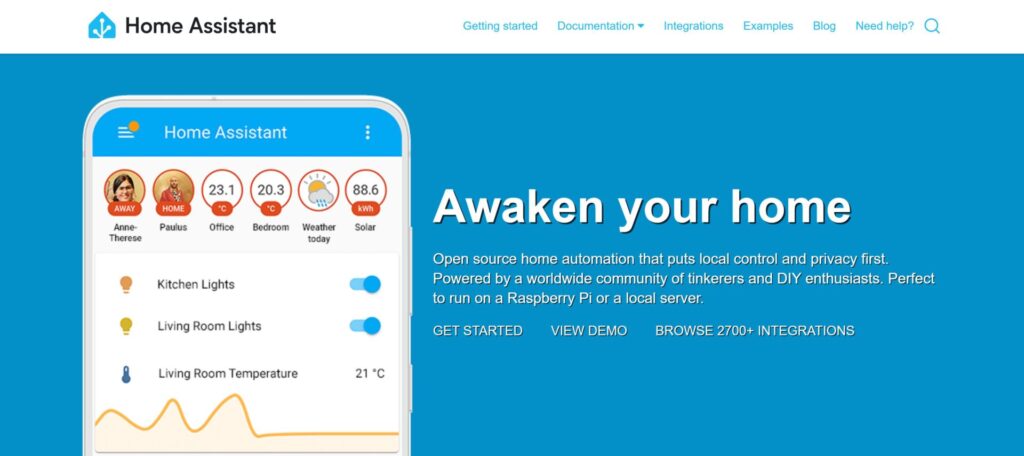
Photo credit: home-assistant.io
Home Assistant has become a prominent player in local smart home platforms. If you prioritize customization, privacy, and local control and you are comfortable with DIY projects and some technical tinkering, Home Assistant offers a rewarding experience.
It is an open-source smart home platform that acts as a local hub for your smart home devices. Unlike cloud-based platforms, it runs on a device you control, like a Raspberry Pi or a dedicated mini PC. With this local processing, you will have wider customization options for automation and wider compatibility with smart home devices through various protocols (Wi-Fi, Zigbee, Z-Wave, etc.). Let’s not forget about privacy. If you use Home Assistant, your smart home data stays within your network, avoiding reliance on external cloud servers. You will also benefit from a large and active community of developers and users for support and troubleshooting.
Cons
- Requires Technical Expertise: Some technical knowledge and comfort with DIY projects are required.
- Steeper Learning Curve: Compared to user-friendly commercial platforms, Home Assistant has a steeper learning curve for initial setup and configuration.
- DIY Hardware Setup: You need to run Home Assistant on a separate device you manage (e.g., Raspberry Pi).
- Limited Support: If you need troubleshooting, there is no customer service, so you will likely rely on community forums and resources.
If you’re a beginner or prefer a user-friendly, ready-to-use solution, commercial smart home platforms might be a better fit.
Matter: Smart Home Device Compatibility
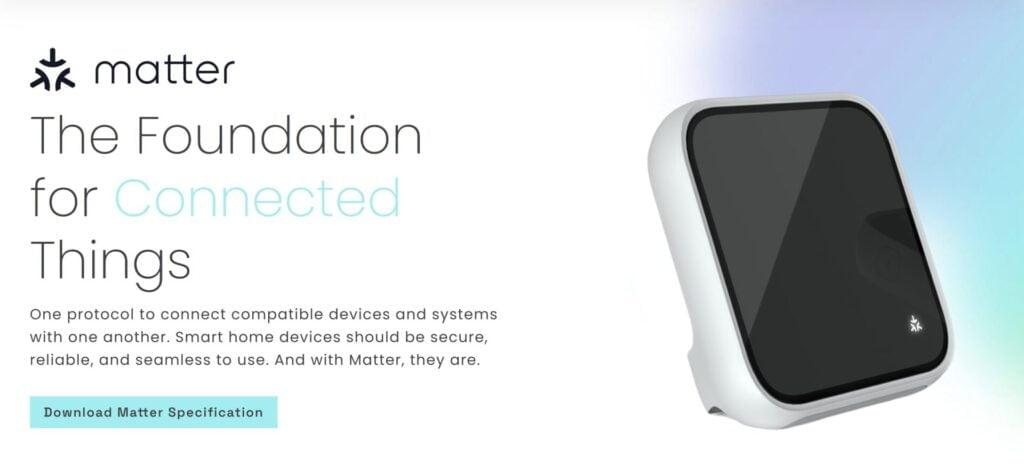
Photo credit: csa-iot.org
Matter is an open-source connectivity standard developed by the Connectivity Standards Alliance (CSA), a consortium of leading smart home platforms and tech companies like Amazon, Apple, Google, Samsung, and others. It simplifies communication between smart home devices regardless of their platform. Imagine Matter is a common language that allows devices from different brands to understand and interact with each other seamlessly.
Currently, smart home devices operate within their own ecosystems, limiting your choices and forcing you to stick with specific brands to ensure compatibility. Matter has the potential to break down these barriers so you can build a more diverse and flexible smart home.
Matter is not designed to replace existing platforms but rather to work alongside them. You’ll likely still interact with your smart home devices primarily through your chosen platform’s app or voice assistant.
It could have the potential to:
- Simplify Setup: The setup would be as easy as connecting the device to your Wi-Fi network and letting it automatically discover and connect to other Matter-certified devices in your home.
- Increase Device Choice: With a unified standard, you won’t be limited to specific platforms when choosing smart home devices.
- Improved Interoperability: In the current situation, devices from different brands require specific platforms or hubs to function together. With Matter, you can mix and match devices from different manufacturers and have them work within a single ecosystem.
- Future-Proofing: The Matter standard is designed to be flexible and adapt to upcoming innovations in smart home technology, potentially extending the lifespan and functionality of your devices.
While Matter is still in its early stages, it’s a promising development to consider when choosing a smart home platform. Matter compatibility will likely initially be seen in newer smart home devices. Existing devices might require firmware updates or hubs to become Matter-enabled, if possible.
Now that you have a better understanding of the leading smart home platforms, it’s time to choose the right smart home devices. To learn more about selecting compatible devices, be sure to read our next article, The Ultimate Guide To Choosing Smart Home Devices.
FAQs
What is a smart home platform?
This is the decision-making center of your smart home. It’s the software system (app or interface) you use to control your devices, set automation, and manage your smart home environment. You can think of it like the mission control that receives information and sends instructions.
Can I use multiple smart home platforms together?
Using multiple smart home platforms is possible but not ideal. You can control devices independently through each platform’s app, or some smart speakers offer limited universal control. However, this can be complex and limit advanced automation features. The upcoming Matter standard might improve compatibility in the future, but for now, a single platform for most devices is recommended for a smoother experience.
What is a smart home hub, and do I need one?
It is the communication hub of your smart home. It’s the physical device that translates commands from the smart home platform into a format your devices (like lights, sensors, etc.) can understand. It also relays information back to the platform.
You likely need a hub if you have many devices from different brands (especially Zigbee or Z-Wave), you want complex automation and you prefer a single platform for control.
You might not need a hub if you have a few devices, all on Wi-Fi or Bluetooth with their own apps, and you’re okay with controlling devices individually. Consider hub features, compatibility with your devices, and cost before deciding.
What are wireless protocols?
These are basically the languages your smart home devices use to talk to each other and the hub. Some common protocols:
- Wi-Fi: Most users are familiar with Wi-Fi. It offers a strong and fast connection, ideal for bandwidth-hungry devices like smart speakers and cameras. However, Wi-Fi can drain battery life for smaller sensors.
- Zigbee: This low-power protocol excels in creating mesh networks, where devices relay signals to each other, extending range. It’s perfect for battery-powered sensors and lights, but communication speed is slower than Wi-Fi.
- Z-Wave: Another low-power protocol known for its reliability and security. It is often used for sensors, locks, and switches. Similar to Zigbee, it offers slower data transfer rates compared to Wi-Fi.
- Bluetooth: Many smart home devices, especially wearables and some sensors, utilize Bluetooth for short-range communication. While convenient for initial setup, it’s not ideal for complex automation due to limited range.
- Thread: This newer, low-power protocol is gaining traction. It focuses on mesh networking security and efficiency, aiming to simplify smart home device communication.
Are smart home platforms secure?
Security varies between platforms. Look for smart home platforms with strong encryption protocols and a good track record on privacy.
Can I control my smart home when I’m away from home?
Yes, most smart home platforms offer remote access through their mobile apps. This allows you to control your devices, monitor your home, and receive notifications even when you’re not there.




